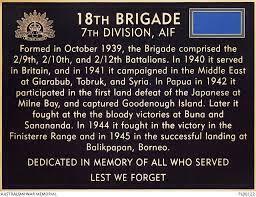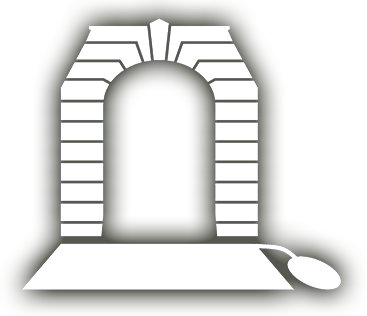
About This Unit
Headquarters 18th Infantry Brigade (WW2)
Following the outbreak of WW2 in 1939, the Army had to move swiftly to be able to commit to undertakings made by the Australian Government to support the British Empire. The pre War Army comprised a very small 'Army Instructional Corps' of Full Time soldiers. The largest part was the part time 'Citizens' Military Forces', or Militia. Under-manned, poorly equipped with an extremely variable standard of training, largely influenced by doctrine and tactics of the Great War, its ranks were leavened with a lot of WW1 veterans. After the outbreak of war it grew enormpously with 'eligible males' conscripted into its ranks. Under Legislation of the time, the Militia could not be sent overseas to fight. So, instead in a decision that still haunts the Army to this day, the 'Second Australian Imperial Force' was raised, specifically to serve overseas. It created a chasm between the two groups, with the men flocking to the Second AIF, deriding the 'chockos' (chocolate 'soldiers') of the CMF who would melt in the heat of batlle or so the lore of the time had it. History would ultimately prove otherwise.
The 6th Division was the first raised following on from the numeric sequence of the Great War. 1st - 5th Division was retained for the CMF. The same naming convention applied to Brigade designations. 1st-15th Brigades were applied to the CMF. The 16th, 17th and 18th Brigades became the first 2nd AIF formations to be raised. Following the pattern of the Great War AIF's antecedence, the 16th Brigade wa drawn mainly form NSW, the 17th from Victoria and the 18th from the 'outer states'.
Each comprising three Battalions, the new units had the prefix '2nd' attached to their title. The 18th Brigade's Battalions were thus the 2nd/9th (Qld), 2nd/10th (SA), 2nd/11th (WA) and 2nd/12th (Tas and Qld).
The 18th Brigade was raised on 13 October 1939. Initially commanded by Brigadier Leslie Morshead (/explore/people/184599), it served in the United Kingdom, the Middle East and the South West Pacific, in New Guinea and Borneo, during the war.
The 2nd AIF was expanding as volunteers swelled their ranks, and the Army re-structured, to conform to British organisation, which had three Battalions per infantry Brigade. So the 2nd/11th was retained in the 6th Division, but the rest of the 18th Brigade was moved from the 6th to the 7th Division and saw out the rest of the war thus.
While on the water on its way to the Middle East, the Brigade was diverted to the UK when threat of invasion seemed imminent during the period of the Battle of Britain.
In November 1940 it was transferred to the Middle East.
The 18th Brigade was detached under Command of the 9th Division during the Siege of Tobruk (/explore/campaigns/85) from April - October 1941. The rest of the Division meanwhile, underpinned Operation Exporter (/explore/campaigns/16), the invasion of Syria, to wrest it from Vichy French control.
With the entry of Japan into the War, Australia demanded the return of the 2nd AIF to take its part in the Defence of Australia. Given the loss of the 8th Division in its entirity in Malaya / Singapore this proved to be very prudent. While the 6th and 7th DIvisions were returned, the 9th stayed in the Middle East and only returned in late 1942 having played a key role at the Battle of El Alamein (/explore/campaigns/53).
The 18th Brigade was reinforced re-equipped and aassigned to the Defence of Milne Bay (/explore/campaigns/52) on new Guinea's easternmost tip. It was there between 25 and 31 August 1942, in the words of Field Marshal Sir William Slim, that "Some of us may forget that, of all the allies, it was the Australians who first broke the invincibility of the Japanese army". (Field-Marshal Sir William Slim, Defeat Into Victory).
Following the repulse of the would be invasion Force weeking to take Port Moresby from the sea, and stabilisation at Milne Bay, the 18th Brigade was moved up the coast in small ships to join the so-called Battles of the Beacheads (/explore/campaigns/93) for Buna Gona and Sanananda
The Brigade later fought in the Lae / Ramu River (/explore/campaigns/79) campaign, and then took part in 'Operation Oboe (/explore/campaigns/76)' in Borneo in the last weeks of WW2..
Following the end of hostilities, the 18th Brigade was disbanded on 3 January 1946.








